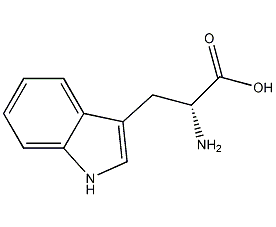D-tryptophan


Structural formula
| Business number | 03Z1 |
|---|---|
| Molecular formula | C11H12N2O2 |
| Molecular weight | 204.23 |
| label |
D-A-amino-3-indolyl-1-propionic acid, D-α-amino-3-indolepropionic acid, (R)-2-amino-3-(3-indolyl)propionic acid, (R)-2-Amino-3-(3-indolyl)propionic acid, D-α-Amino-3-indolepropionic acid |
Numbering system
CAS number:153-94-6
MDL number:MFCD00005647
EINECS number:205-819-9
RTECS number:YN6129000
BRN number:86198
PubChem number:24900598
Physical property data
1. Physical property data:
1. Appearance: white or off-white crystalline powder
2. Density (g/mL, 25/4℃): 1.065
3. Melting point (℃):282-285℃
4. Specific optical rotation (º, C=1, WATER):31.5°
5. Solubility:Soluble in hot ethanol, alkali solution and water, insoluble in chloroform, aqueous solution is Weakly acidic.
Toxicological data
2. Toxicological data:
1, acute toxicity: rat abdominal cavity LD50: 4289 mg/kg
Ecological data
3. Ecological data:
Other harmful Effect: This substance may be harmful to the environment, and special attention should be paid to water bodies.
Molecular structure data
5. Molecular property data: 1. Molar refractive index:57.76 2. Molar volume (m3/ mol):149.8 3. Isotonic specific volume (90.2K): 435.3 4. Surface tension (dyne/cm): 71.1 5. Polarizability(10-24cm3):22.90
Compute chemical data
1. Reference value for hydrophobic parameter calculation (XlogP): None
2. Number of hydrogen bond donors: 3
3. Number of hydrogen bond acceptors: 35. Molecular property data:
1. Molar refractive index:57.76
2. Molar volume (m3/ mol):149.8
3. Isotonic specific volume (90.2K): 435.3
4. Surface tension (dyne/cm): 71.1
5. Polarizability(10-24cm3):22.90
Compute chemical data
1. Reference value for hydrophobic parameter calculation (XlogP): None
2. Number of hydrogen bond donors: 3
3. Number of hydrogen bond acceptors: 3
4. Number of rotatable chemical bonds: 3
5. Number of tautomers: none
6. Topological molecule polar surface area 79.1
7. Number of heavy atoms: 15
8. Surface charge: 0
9. Complexity: 245
10. Number of isotope atoms: 0
11. Determine the number of atomic stereocenters: 1
12. Uncertain number of atomic stereocenters: 0
13. Determine the number of chemical bond stereocenters: 0
14. Number of uncertain chemical bond stereocenters: 0
15. Number of covalent bond units: 1
Properties and stability
Stable under normal temperature and pressure.
Incompatible materials:Strong oxidizing agentStorage method
Save in a dry and cool place.
Synthesis method
withDL-Tryptophan is used as raw material. Add chloroacetic anhydride under cooling to react. It is acidified with sulfuric acid and then ground in ice water. After filtration, it is recrystallized in water. Finally, it is treated with pancreatic carboxypeptidase and removed. L- type, refined by acidification with acetic acid and recrystallization from ethanol.
Purpose
1.For biochemical research.
2. is an important nutrient and is used medicinally for the prevention and treatment of pellagra. agent.
>
4. Number of rotatable chemical bonds: 3
5. Number of tautomers: none
6. Topological molecule polar surface area 79.1
7. Number of heavy atoms: 15
8. Surface charge: 0
9. Complexity: 245
10. Number of isotope atoms: 0
11. Determine the number of atomic stereocenters: 1
12. Uncertain number of atomic stereocenters: 0
13. Determine the number of chemical bond stereocenters: 0
14. Number of uncertain chemical bond stereocenters: 0
15. Number of covalent bond units: 1
Properties and stability
Stable under normal temperature and pressure.
Incompatible materials:Strong oxidizing agentStorage method
Save in a dry and cool place.
Synthesis method
withDL-Tryptophan is used as raw material. Add chloroacetic anhydride under cooling to react. It is acidified with sulfuric acid and then ground in ice water. After filtration, it is recrystallized in water. Finally, it is treated with pancreatic carboxypeptidase and removed. L- type, refined by acidification with acetic acid and recrystallization from ethanol.
Purpose
1.For biochemical research.
2. is an important nutrient and is used medicinally for the prevention and treatment of pellagra. agent.